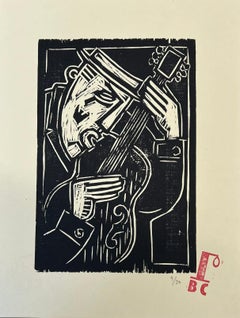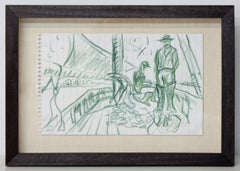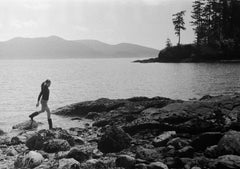Billy Childish Art
English, b. 1959
Billy Childish (b. 1959, Chatham, Kent, United Kingdom; lives and works in Whitstable, Kent) is known for his introspective, autobiographical, and deeply emotional paintings, writing, and music. After leaving secondary school at age 16, Childish worked at the Naval Dockyard in Chatham as an apprentice stonemason. Initially denied an interview to the local art school, he produced hundreds of drawings that gained him entry to London’s Saint Martin's School of Art. Childish's defiance of authority led to his eventual expulsion from art school in 1981. Since then, Childish has gained something of a cult status worldwide, writing and publishing several novels and more than 40 volumes of confessional poetry, recording more than 150 LPs, and painting several hundred works. Through all of these disciplines, Childish addresses social, political, and personal issues such as war, protest, his turbulent childhood, and his struggles with addiction.
While his confessional poetry and music explore these issues with startling honesty, Childish’s paintings are more subtle. His subjects are often drawn from his environment or are people he knows or admires: birch forests, self-portraits, a lone figure in a pastoral English landscape, and his wife as a reclining female nude. Childish works quickly and intuitively, making spare marks on raw canvas that leave much of it visible. He identifies with artists who worked outside a group or movement, intrigued by their outsider roles in society, such as Vincent van Gogh, Kurt Schwitters, and Edvard Munch. Labeling himself a “radical traditionalist,” Childish has a reverence for traditional oil painting yet has resolutely resisted any connection with a particular group or artistic movement.(Biography provided by Lehmann Maupin)
to
4
3
2
4
3
3
3
1
Overall Height
to
Overall Width
to
7
4
3
2
1
1
1
1
1
1
1
1
1
1
1
1
1
7
7
7,006
3,388
2,513
1,212
3
2
2
2
2
Artist: Billy Childish
Man With Guitar By Billy Childish
By Billy Childish
Located in London, GB
Man With Guitar
By Billy Childish
Billy Childish is a British artist, musician, poet, and writer known for his raw, uncompromising creativity across various mediums, emerging from...
Category
2010s Contemporary Billy Childish Art
Materials
Paper, Woodcut
Toni Kurz Descending
By Billy Childish
Located in New York, NY
Billy Childish (b. 1959, Chatham, Kent, United Kingdom; lives and works in Whitstable, Kent) is known for his introspective, autobiographical, and deeply emotional paintings, writing...
Category
2010s Contemporary Billy Childish Art
Materials
Etching
Man Seated (Oyster Catchers, Thames Estuary 1932)
By Billy Childish
Located in New York, NY
Billy Childish (b. 1959, Chatham, Kent, United Kingdom; lives and works in Whitstable, Kent) is known for his introspective, autobiographical, and deeply emotional paintings, writing...
Category
2010s Contemporary Billy Childish Art
Materials
Paper, Color Pencil
Painter. Chatham Dockyard, 2020
By Billy Childish
Located in New York, NY
Billy Childish (b. 1959, Chatham, Kent, United Kingdom; lives and works in Whitstable, Kent) is known for his introspective, autobiographical, and deeply emotional paintings, writing...
Category
2010s Contemporary Billy Childish Art
Materials
Archival Pigment
Orcas Island, Wa State. circa 2000
By Billy Childish
Located in New York, NY
Billy Childish (b. 1959, Chatham, Kent, United Kingdom; lives and works in Whitstable, Kent) is known for his introspective, autobiographical, and deeply emotional paintings, writing...
Category
2010s Contemporary Billy Childish Art
Materials
Archival Pigment
Man Standing (Oyster Catchers, Thames Estuary 1932)
By Billy Childish
Located in New York, NY
Billy Childish (b. 1959, Chatham, Kent, United Kingdom; lives and works in Whitstable, Kent) is known for his introspective, autobiographical, and deeply emotional paintings, writing...
Category
2010s Contemporary Billy Childish Art
Materials
Color Pencil, Paper
Sailish Fisherman
By Billy Childish
Located in London, GB
hand-signed and numbered by the artist.
5 colour hand-pulled lithograph with 11 screen printed colours on Somerset Velvet Warm White 400gsm
73 x 89 cm
Edition of 75
Billy Childis...
Category
2010s Contemporary Billy Childish Art
Materials
Lithograph
Related Items
The pagoda, from The Hippies
By Salvador Dalí
Located in Washington, DC
Artist: Salvador Dali
Title: The pagoda
Portfolio: The Hippies
Medium: Color etching on Arches
Date: 1969
Edition: 102/145
Frame Size: 31" x 26 1/2"
Sheet Size: 26" x 20"
Image Size:...
Category
1960s Surrealist Billy Childish Art
Materials
Etching
Santiago of Compostela, from The Hippies
By Salvador Dalí
Located in Washington, DC
Artist: Salvador Dali
Title: Santiago of Compostela
Portfolio: The Hippies
Medium: Color etching on Arches
Date: 1969
Edition: 102/145
Frame Size: 31" x 26 1/2"
Sheet Size: 26" x 20"...
Category
1960s Surrealist Billy Childish Art
Materials
Etching
Mexican Artit ¨Doña Caracola llega tarde a Palacio¨ signed limited edition print
By Francisco Toledo
Located in Miami, FL
Francisco Toledo (Mexico, 1940-2019)
'Doña Caracola llega tarde a Palacio', 1991
woodcut on paper
20.7 x 29.6 in. (52.5 x 75 cm.)
Edition of 22
Unframed
Category
1970s Contemporary Billy Childish Art
Materials
Woodcut, Paper
Marc Chagall - Bath-Sheba at the Feet of David - Original Handsigned Etching
By Marc Chagall
Located in Collonge Bellerive, Geneve, CH
Marc Chagall - Bath-Sheba at the Feet of David - Original Handsigned Etching
1958
Printed by Tériade
Dimensions: 54 x 39 cm
Handsigned and numbered
handcolored
Edition: 100
Reference: Cramer 30.
Etching with hand-coloring, circa 1930, initialled in pencil, numbered 75/100 (there were also twenty hors-commerce copies) , published 1958 by Tériade, Paris, on Arches wove paper
Marc Chagall (born in 1887)
Marc Chagall was born in Belarus in 1887 and developed an early interest in art. After studying painting, in 1907 he left Russia for Paris, where he lived in an artist colony on the city’s outskirts. Fusing his own personal, dreamlike imagery with hints of the fauvism and cubism popular in France at the time, Chagall created his most lasting work—including I and the Village (1911)—some of which would be featured in the Salon des Indépendants exhibitions. After returning to Vitebsk for a visit in 1914, the outbreak of WWI trapped Chagall in Russia. He returned to France in 1923 but was forced to flee the country and Nazi persecution during WWII. Finding asylum in the U.S., Chagall became involved in set and costume design before returning to France in 1948. In his later years, he experimented with new art forms and was commissioned to produce numerous large-scale works. Chagall died in St.-Paul-de-Vence in 1985.
The Village
Marc Chagall was born in a small Hassidic community on the outskirts of Vitebsk, Belarus, on July 7, 1887. His father was a fishmonger, and his mother ran a small sundries shop in the village. As a child, Chagall attended the Jewish elementary school, where he studied Hebrew and the Bible, before later attending the Russian public school. He began to learn the fundamentals of drawing during this time, but perhaps more importantly, he absorbed the world around him, storing away the imagery and themes that would feature largely in most of his later work.
At age 19 Chagall enrolled at a private, all-Jewish art school and began his formal education in painting, studying briefly with portrait artist Yehuda Pen. However, he left the school after several months, moving to St. Petersburg in 1907 to study at the Imperial Society for the Protection of Fine Arts. The following year, he enrolled at the Svanseva School, studying with set designer Léon Bakst, whose work had been featured in Sergei Diaghilev's Ballets Russes. This early experience would prove important to Chagall’s later career as well.
Despite this formal instruction, and the widespread popularity of realism in Russia at the time, Chagall was already establishing his own personal style, which featured a more dreamlike unreality and the people, places and imagery that were close to his heart. Some examples from this period are his Window Vitebsk (1908) and My Fianceé with Black Gloves (1909), which pictured Bella Rosenfeld, to whom he had recently become engaged.
The Beehive
Despite his romance with Bella, in 1911 an allowance from Russian parliament member and art patron Maxim Binaver enabled Chagall to move to Paris, France. After settling briefly in the Montparnasse neighborhood, Chagall moved further afield to an artist colony known as La Ruche (“The Beehive”), where he began to work side by side with abstract painters such as Amedeo Modigliani and Fernand Léger as well as the avant-garde poet Guillaume Apollinaire. At their urging, and under the influence of the wildly popular fauvism and cubism, Chagall lightened his palette and pushed his style ever further from reality. I and the Village (1911) and Homage to Apollinaire (1912) are among his early Parisian works, widely considered to be his most successful and representative period.
Though his work stood stylistically apart from his cubist contemporaries, from 1912 to 1914 Chagall exhibited several paintings at the annual Salon des Indépendants exhibition, where works by the likes of Juan Gris, Marcel Duchamp and Robert Delaunay were causing a stir in the Paris art world. Chagall’s popularity began to spread beyond La Ruche, and in May 1914 he traveled to Berlin to help organize his first solo exhibition, at Der Sturm Gallery. Chagall remained in the city until the highly acclaimed show opened that June. He then returned to Vitebsk, unaware of the fateful events to come.
War, Peace and Revolution
In August 1914 the outbreak of World War I precluded Chagall’s plans to return to Paris. The conflict did little to stem the flow of his creative output, however, instead merely giving him direct access to the childhood scenes so essential to his work, as seen in paintings such as Jew in Green (1914) and Over Vitebsk (1914). His paintings from this period also occasionally featured images of the war’s impact on the region, as with Wounded Soldier (1914) and Marching (1915). But despite the hardships of life during wartime, this would also prove to be a joyful period for Chagall. In July 1915 he married Bella, and she gave birth to a daughter, Ida, the following year. Their appearance in works such as Birthday (1915), Bella and Ida by the Window (1917) and several of his “Lovers” paintings give a glimpse of the island of domestic bliss that was Chagall’s amidst the chaos.
To avoid military service and stay with his new family, Chagall took a position as a clerk in the Ministry of War Economy in St. Petersburg. While there he began work on his autobiography and also immersed himself in the local art scene, befriending novelist Boris Pasternak, among others. He also exhibited his work in the city and soon gained considerable recognition. That notoriety would prove important in the aftermath of the 1917 Russian Revolution when he was appointed as the Commissar of Fine Arts in Vitebsk. In his new post, Chagall undertook various projects in the region, including the 1919 founding of the Academy of the Arts. Despite these endeavors, differences among his colleagues eventually disillusioned Chagall. In 1920 he relinquished his position and moved his family to Moscow, the post-revolution capital of Russia.
In Moscow, Chagall was soon commissioned to create sets and costumes for various productions at the Moscow State Yiddish Theater, where he would paint a series of murals titled Introduction to the Jewish Theater as well. In 1921, Chagall also found work as a teacher at a school for war orphans. By 1922, however, Chagall found that his art had fallen out of favor, and seeking new horizons he left Russia for good.
Flight
After a brief stay in Berlin, where he unsuccessfully sought to recover the work exhibited at Der Sturm before the war, Chagall moved his family to Paris in September 1923. Shortly after their arrival, he was commissioned by art dealer and publisher Ambroise Vollard to produce a series of etchings for a new edition of Nikolai Gogol's 1842 novel Dead Souls. Two years later Chagall began work on an illustrated edition of Jean de la Fontaine’s Fables, and in 1930 he created etchings for an illustrated edition of the Old Testament, for which he traveled to Palestine to conduct research.
Chagall’s work during this period brought him new success as an artist and enabled him to travel throughout Europe in the 1930s. He also published his autobiography, My Life (1931), and in 1933 received a retrospective at the Kunsthalle in Basel, Switzerland. But at the same time that Chagall’s popularity was spreading, so, too, was the threat of Fascism and Nazism. Singled out during the cultural "cleansing" undertaken by the Nazis in Germany, Chagall’s work was ordered removed from museums throughout the country. Several pieces were subsequently burned, and others were featured in a 1937 exhibition of “degenerate art” held in Munich. Chagall’s angst regarding these troubling events and the persecution of Jews in general can be seen in his 1938 painting White Crucifixion.
With the eruption of World War II, Chagall and his family moved to the Loire region before moving farther south to Marseilles following the invasion of France. They found a more certain refuge when, in 1941, Chagall’s name was added by the director of the Museum of Modern Art (MOMA) in New York City to a list of artists and intellectuals deemed most at risk from the Nazis’ anti-Jewish campaign. Chagall and his family would be among the more than 2,000 who received visas and escaped this way.
Haunted Harbors
Arriving in New York City in June 1941, Chagall discovered that he was already a well-known artist there and, despite a language barrier, soon became a part of the exiled European artist community. The following year he was commissioned by choreographer Léonide Massine to design sets and costumes for the ballet Aleko, based on Alexander Pushkin’s “The Gypsies” and set to the music of Pyotr Ilyich Tchaikovsky.
But even as he settled into the safety of his temporary home, Chagall’s thoughts were frequently consumed by the fate befalling the Jews of Europe and the destruction of Russia, as paintings such as The Yellow Crucifixion...
Category
1960s Surrealist Billy Childish Art
Materials
Etching
H 21.26 in W 15.36 in D 0.04 in
The sacred cow, from The Hippies
By Salvador Dalí
Located in Washington, DC
Artist: Salvador Dali
Title: The sacred cow
Portfolio: The Hippies
Medium: Color etching on Arches
Date: 1969
Edition: 102/145
Frame Size: 31" x 26 1/2"
Sheet Size: 26" x 20"
Image S...
Category
1960s Surrealist Billy Childish Art
Materials
Etching
Woman in the waves, from The Hippies
By Salvador Dalí
Located in Washington, DC
Artist: Salvador Dali
Title: Woman in the waves
Portfolio: The Hippies
Medium: Color etching on Arches
Date: 1969
Edition: 102/145
Frame Size: 31" x...
Category
1960s Surrealist Billy Childish Art
Materials
Etching
Woman with the garter, from The Hippies
By Salvador Dalí
Located in Washington, DC
Artist: Salvador Dali
Title: Woman with the garter
Portfolio: The Hippies
Medium: Color etching on Arches
Date: 1969
Edition: 102/145
Frame Size: 31" x 26 1/2"
Sheet Size: 26" x 20"
...
Category
1960s Surrealist Billy Childish Art
Materials
Etching
The old hippie, from The Hippies
By Salvador Dalí
Located in Washington, DC
Artist: Salvador Dali
Title: The old hippie
Portfolio: The Hippies
Medium: Color etching on Arches
Date: 1969
Edition: 102/145
Frame Size: 31" x 26 1/2"
Sheet Size: 26" x 20"
Image S...
Category
1960s Surrealist Billy Childish Art
Materials
Etching
Woman with cushion, from The Hippies
By Salvador Dalí
Located in Washington, DC
Artist: Salvador Dali
Title: Woman with cushion
Portfolio: The Hippies
Medium: Color etching on Arches
Date: 1969
Edition: 102/145
Frame Size: 31" x 26 1/2"
Sheet Size: 26" x 20"
Ima...
Category
1960s Surrealist Billy Childish Art
Materials
Etching
Acrobats - Etching boy Marino Marini - 1963
By Marino Marini
Located in Roma, IT
Hand signed and numbered. Edition of 50 prints.
From the book "Idea e Spazio" including 12 etchings by Marino Marini and poems by Egle Marini.
Ref.: Toninelli n. 80.
Image dimensio...
Category
1960s Contemporary Billy Childish Art
Materials
Etching
Mexican Artist ¨Cinderella¨signed limited edition original art print lithograph
By Francisco Toledo
Located in Miami, FL
Francisco Toledo (Mexico, 1940-2019)
'Cinderella', 1984
lithograph on paper
29.9 x 22.1 in. (75.9 x 55.9 cm.)
Edition of 45
Unframed
Category
1980s Contemporary Billy Childish Art
Materials
Woodcut, Paper
The cosmonaut, from The Hippies
By Salvador Dalí
Located in Washington, DC
Artist: Salvador Dali
Title: The cosmonaut
Portfolio: The Hippies
Medium: Color etching on Arches
Date: 1969
Edition: 102/145
Frame Size: 31" x 26 1/2"
Sheet Size: 26" x 20"
Image Si...
Category
1960s Surrealist Billy Childish Art
Materials
Etching
Billy Childish art for sale on 1stDibs.
Find a wide variety of authentic Billy Childish art available for sale on 1stDibs. You can also browse by medium to find art by Billy Childish in archival pigment print, color pencil, paper and more. Much of the original work by this artist or collective was created during the 21st century and contemporary and is mostly associated with the contemporary style. Not every interior allows for large Billy Childish art, so small editions measuring 8 inches across are available. Customers who are interested in this artist might also find the work of John Rettie, Tami Bahat, and Ken Burton. Billy Childish art prices can differ depending upon medium, time period and other attributes. On 1stDibs, the price for these items starts at $750 and tops out at $7,645, while the average work can sell for $4,433.







